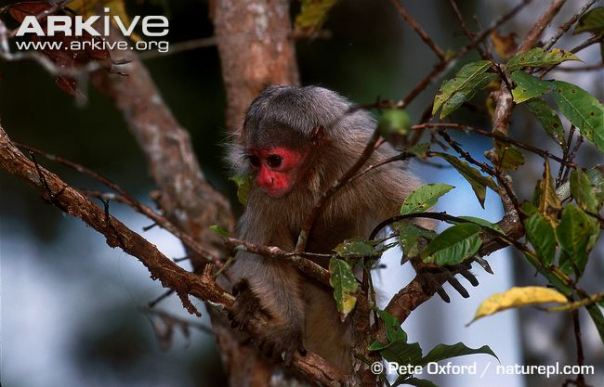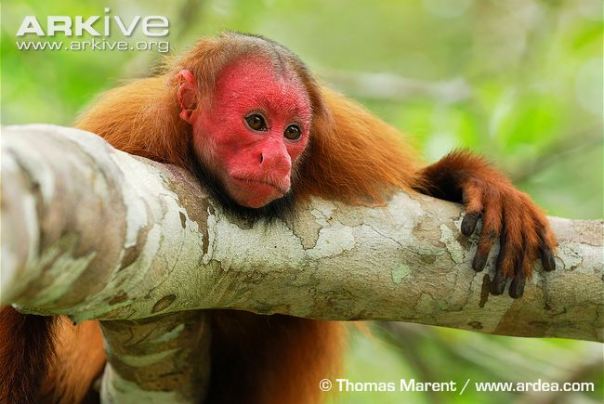- Name: Bald uakari
- Latin: Cacajao calvus
- Classification: Mammal
- Origin: South America
- Lifespan: 15-20 years
Taxonomy
Kingdom: Animalia (Animals)
Phylum: Chordata (Vertebrates)
Class: Mammalia (Mammals)
Order: Primates (Primates)
Family: Pitheciidae (New World Monkeys)
Genus: Cacajao (Uakaris)
Species: Cacajao Calvus (Bald Uakari)
Apperance
Length (body): 54-57cm
Length (tail): 14-18.5cm
Weight: (Male) 3.45kg (Female) 2.9kg
The bald uakari has a long shaggy coat which varies from reddish-brown to orange. It has a striking bald head and a bright red face, which is a sign of good health. Unlike other monkeys, the bald uakari has a very short tail. However, its long limbs are more than capable of swinging nimbly through the trees.
Relatives
- Atlantic titi (Callicebus personatus) -VULNERABLE-
- Black-headed uakari (Cacajao melanocephalus) -LEAST CONCERN-
- White-nosed saki (Chiropotes albinasus) -ENDANGERED-
- Monk saki (Pithecia monachus) -LEAST CONCERN-
Habitat & Distribution
Bald uakaris live only along the Amazon River basin in South America. They prefer to live in permanently or seasonally flooded rainforest and locations near water sources, such as small rivers and lakes.

Diet
The diet of the bald uakari consists mostly of seeds, flowers and even some small animals. Its diet is determined by season. In the rainy season, it stays in the treetops and feeds on fruits, but in the dry season it ventures to the forest floor to forage for seedlings.
Behaviour
Bald uakaris live in groups containing males and females, and its size usually ranges between 10-20 members. However, troops containing over 100 individuals have been recorded. These monkeys have been known to socialise with other similar primates, such as squirrel monkeys and will forage for food together. The bald uakari is diurnal, meaning it is active during the day and sleeps during the night.
Reproduction
A female bald uakari will be able to produce a single young once every 2 years. It has no specific breeding season and pregnancy will normally last around 182 days. The young are nursed for 3-5 months then they can begin to eat soft fruits. Females are sexually mature at 3 years old, males at 6 years.

Adaptations
- The bald uakari’s main characteristic is its red face. A female will only pick a male to mate with if it has a very red face as it is a sign of good health.
- Like most monkeys, the bald Uakari has long limbs which help it to be swift and nimble when moving through the tree tops.
- This monkey has long brown fur which keeps it warm during the cold forest nights in the trees.
- The bald Uakari has sharp incisors and canines which help it to break into nut and fruit shells.
Threats
The bald uakari is rarely hunted because its appearance is said to be too human-like. The main threat to their survival is the loss of its flooded forest habitat. The deforestation of its habitat is down to small scale agricultural activity in the area and logging.
Conservation
IUCN Status: Vulnerable
The bald uakari is protected by CITES Appendix I, the Primate Protection Centre (PPC), the Pitheciine Action Group (PAG) and the Peruvian government which prohibits hunting, capturing, owning, transporting and exportation of this animal for commercial purposes.
It is also protected by the following actions:
Land/water management,
Site/area management,
Species management,
Harvest management,
Fun Facts
Male: Male Monkey
Female: Female Monkey
Young: Infant
Group: Troop
-Red faces are a symbol of good health,
-Females are bigger than males,
-Forms large social group of up to 100 individuals,
-Diurnal (awake at day, sleep at night),
